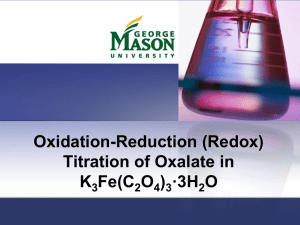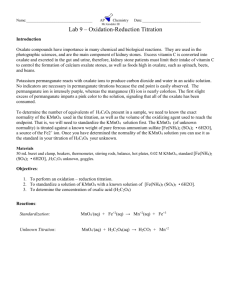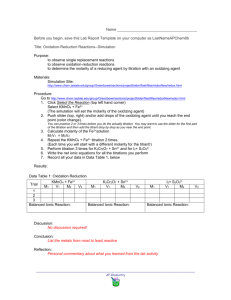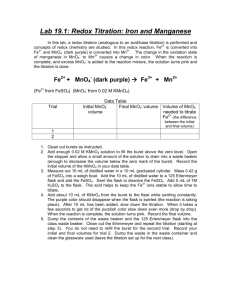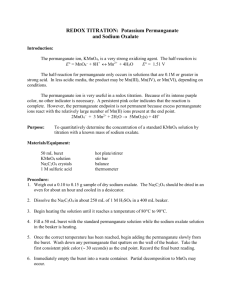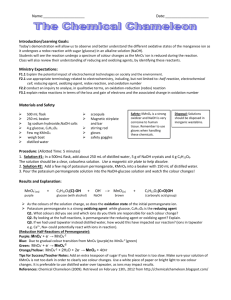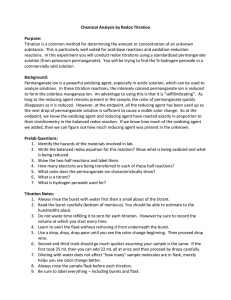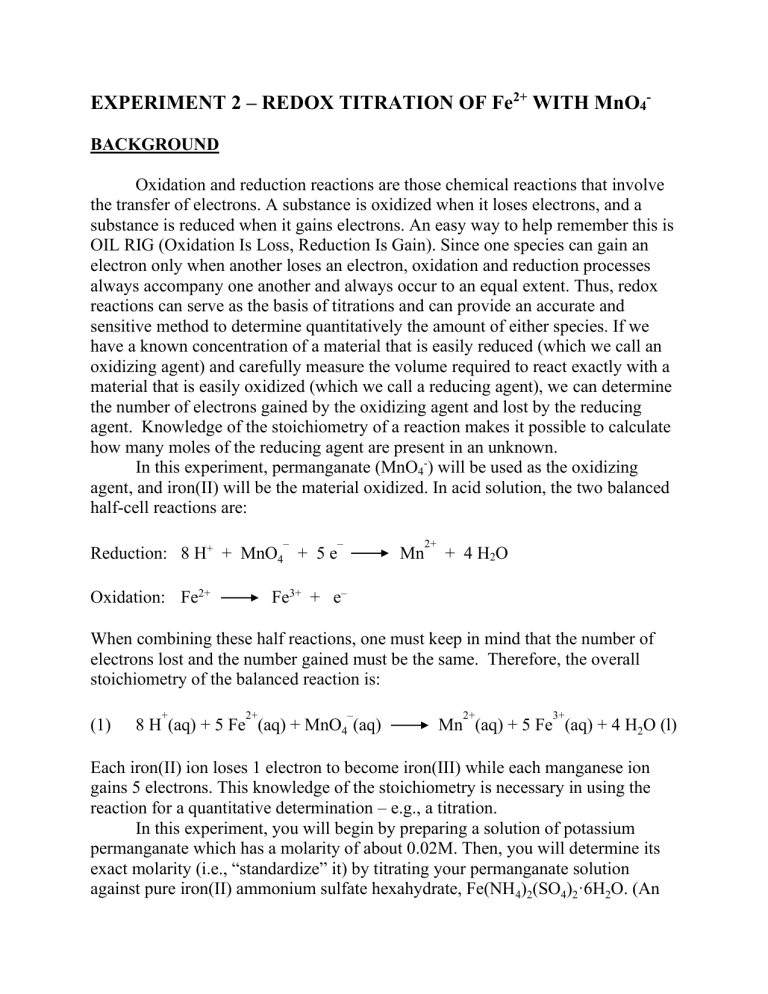
EXPERIMENT 2 – REDOX TITRATION OF Fe2+ WITH MnO4BACKGROUND Oxidation and reduction reactions are those chemical reactions that involve the transfer of electrons. A substance is oxidized when it loses electrons, and a substance is reduced when it gains electrons. An easy way to help remember this is OIL RIG (Oxidation Is Loss, Reduction Is Gain). Since one species can gain an electron only when another loses an electron, oxidation and reduction processes always accompany one another and always occur to an equal extent. Thus, redox reactions can serve as the basis of titrations and can provide an accurate and sensitive method to determine quantitatively the amount of either species. If we have a known concentration of a material that is easily reduced (which we call an oxidizing agent) and carefully measure the volume required to react exactly with a material that is easily oxidized (which we call a reducing agent), we can determine the number of electrons gained by the oxidizing agent and lost by the reducing agent. Knowledge of the stoichiometry of a reaction makes it possible to calculate how many moles of the reducing agent are present in an unknown. In this experiment, permanganate (MnO4-) will be used as the oxidizing agent, and iron(II) will be the material oxidized. In acid solution, the two balanced half-cell reactions are: – Reduction: 8 H+ + MnO4 + 5 e – Mn 2+ + 4 H2O Fe3+ + e– Oxidation: Fe2+ When combining these half reactions, one must keep in mind that the number of electrons lost and the number gained must be the same. Therefore, the overall stoichiometry of the balanced reaction is: (1) + 2+ – 8 H (aq) + 5 Fe (aq) + MnO4 (aq) 2+ 3+ Mn (aq) + 5 Fe (aq) + 4 H2O (l) Each iron(II) ion loses 1 electron to become iron(III) while each manganese ion gains 5 electrons. This knowledge of the stoichiometry is necessary in using the reaction for a quantitative determination – e.g., a titration. In this experiment, you will begin by preparing a solution of potassium permanganate which has a molarity of about 0.02M. Then, you will determine its exact molarity (i.e., “standardize” it) by titrating your permanganate solution against pure iron(II) ammonium sulfate hexahydrate, Fe(NH4)2(SO4)2·6H2O. (An older name for this compound is ferrous ammonium sulfate.) In this titration, the – permanganate ion will serve as its own indicator. The MnO4 ion is deep purple, 2+ but the Mn ion is colorless (as are both Fe2+ and Fe3+). Therefore, when all the 2+ – Fe has been consumed, the added MnO4 will no longer react and will cause the solution to turn pink. The first hint of a stable pink color signals the end point of the titration. You will do three of these standardization titrations and use the average as the concentration of the permanganate solution. After having standardized your permanganate solution, you will be given an iron(II) unknown in the form of a white crystalline powder. You will weigh out, dissolve, and titrate three samples of this unknown using your standardized permanganate solution and determine the average percent Fe present in the unknown. EXPERIMENTAL PROCEDURE Preparation of approximate permanganate solution (~0.02 M MnO4-) 1. Weigh approximately 0.65 grams of KMnO4 onto weigh paper. Place about 75 mL of deionized water in a 600 mL beaker, add about a third of the permanganate to the water, and stir well. Add another 75 mL of water to the beaker and another one-third of the permanganate. Continue stirring. Finally add 50 mL of water to the beaker along with the rest of the permanganate and stir well for several minutes. Let the solution sit for about 5 minutes while you clean your buret thoroughly with soap and water. Carefully decant the permanganate solution into a 400 mL beaker. Don't allow any undissolved or solid material to be transferred to the 400 mL beaker (transferred solids will clog the buret!). The resulting solution is approximately 0.02 M and will be used for all your titrations. 2. After rinsing the clean buret at least 3 times with water, rinse it 3 more times with small amounts (about 5 mL) of the permanganate solution and then fill the buret with the permanganate solution. This solution may be too deeply colored to allow you to read the bottom of the meniscus; if so, you will need to read the top of the liquid column instead. Standardization of the permanganate solution 3. Weigh carefully three portions (approximately 1 gram each) of the iron(II) ammonium sulfate (Fe-ASH) into 3 Erlenmeyer flasks. Record the weight accurately to 0.0001 g. Dissolve the samples in about 40 mL of deionized water. 4. Add approximately 10 mL of 2.0 M sulfuric acid to each Erlenmeyer flask just before starting the titration. IMPORTANT! Don't forget to add the sulfuric acid! To make the color change more easily seen, place a piece of white paper under the Erlenmeyer flask. Begin the titration by adding the potassium permanganate solution carefully to the flask, swirling constantly. As soon as the color of an additional drop fades rather slowly, add the permanganate solution 1 drop at a time. When the pink color persists for 30 seconds, stop the titration and read the buret. Refill the buret and repeat the procedure with the second and third sample. Report the concentration of your permanganate solution as an average of all trials, including the 95% confidence interval. Determination of the %Fe in the unknown 5. Using the balance, accurately weigh three portions (approximately 1 gram each) of the iron(II) containing unknown into three Erlenmeyer flasks. Record the weight accurately to 0.0001 g. Dissolve the samples in about 40 mL of deionized water. Refill the buret with permanganate solution and proceed as in the standardization procedure above. DON'T forget to add the sulfuric acid just before starting the titration! Calculate the mass of Fe(II) present and the percent Fe(II) in the unknown. Report your results as an average of all three trials, including the 95% confidence interval. CHEM 208 PRELAB QUESTIONS FOR EXPERIMENT 3: REDOX TITRATION OF Fe2+ WITH MnO4Name________________________________________ Section_________ TA Name_____________________________________ 1. (3 points) Write the balanced chemical equation that corresponds to the titration of Fe2+ with MnO4-. __________________________________________________________ 2. (3 points) Suppose that 0.2553 moles of MnO4- were required to exactly titrate 2+ 2+ the Fe in a sample. How many moles of Fe were in the sample? 3. (3 points) Suppose that 22.65 mL of a 0.02024 M permanganate solution was 2+ needed to react with the Fe in a sample that had a mass of 1.1243 g. What is the 2+ 2+ mass of the Fe in the sample and what is the % of Fe in the sample? 4. (6 points) Balance the following oxidation-reduction (redox) reactions. SHOW YOUR WORK. (a) C + H2SO4 CO2 + (b) Ag + H2SO4 Ag2SO4 + (c) ClO3- + Cl- Cl2 SO2 + SO2 ClO2- CHEM 208 LAB WRITE-UP FOR EXPERIMENT 3: REDOX TITRATION OF Fe2+ WITH MnO4Name____________________________________ Section______________ TA Name_________________________________ Date________________ Unknown #_______________________________ Standardization of permanganate solution (steps 3 and 4) Initial buret reading (KMnO4) Final buret reading (KMnO4) Volume KMnO4 used Trial 1 2 3 Mass Fe-ASH n Fe2+ Trial 1 Trial 2 Trial 3 __________ __________ __________ __________ __________ __________ __________ __________ __________ n MnO4- Vol KMnO4 used M KMnO4 Note that "n" means “number of moles” Sample calculation for n Fe2+, n MnO4-, and M KMnO4 for Trial 1: Q test (90%) of M KMnO4 (show calculation): Confidence Interval (95%) of M KMnO4 (show calculation): Average M KMnO4 ± 95% Conf. Interval.:_______________________________ Determination of mass Fe2+ in the unknown (step 5) Initial buret reading (KMnO4) Final buret reading (KMnO4) Volume KMnO4 used Trial Trial 1 Trial 2 Trial 3 __________ __________ __________ __________ __________ __________ __________ __________ __________ Average M Vol KMnO4 n MnO4- n Fe2+ KMnO4 used Mass Fe2+ Weight of Unknown % Weight Fe2+ 1 2 3 Sample calculation of n MnO4-, n Fe2+, mass Fe2+, and % weight Fe2+ for Trial 1: Q test (90%) of % Weight Fe2+ (show calculation): Confidence Interval (95%) of % Weight Fe2+ (show calculation): Final result: Unknown number Average % Weight Fe2+ ± 95% Conf. Interval For TA Use Accuracy_______________________ Grade__________________________

